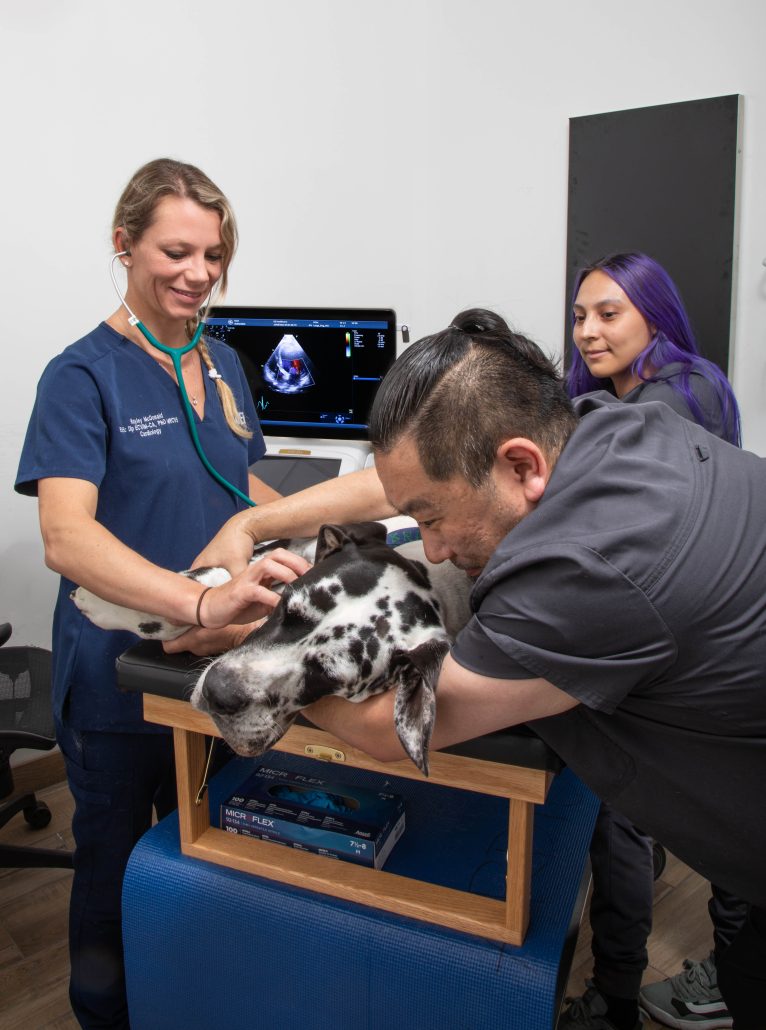The Function of Ultrasound and CT Check in Modern Veterinary Practices: Insights From Experienced Professionals
In contemporary vet practices, ultrasound and CT scans significantly boost diagnostic abilities. These imaging strategies supply essential understandings into animal wellness, directing treatment choices. Experienced professionals acknowledge the one-of-a-kind advantages of each method. Ultrasound offers real-time analyses, while CT checks supply detailed anatomical details. Recognizing their applications and functions increases essential questions about their influence on client outcomes and the future of veterinary diagnostics. What understandings can be acquired from their combined use?
Recognizing Ultrasound in Veterinary Medication
Ultrasound is a vital diagnostic tool in vet medicine, using a non-invasive method to envision inner frameworks. This imaging strategy utilizes high-frequency sound waves to produce real-time photos of body organs and cells, permitting veterinarians to evaluate problems without medical intervention. Common applications consist of evaluating the heart, liver, kidneys, and reproductive organs, along with keeping an eye on pregnancies.The treatment is relatively quick and can be carried out in numerous setups, making it an easily accessible alternative for vets. Unlike radiography, ultrasound gives in-depth info about soft tissues and blood circulation, which is vital for precise diagnoses.Veterinary professionals depend on ultrasound to spot problems such as tumors, cysts, and fluid accumulation. Its capability to lead biopsies and other procedures additionally boosts its energy in professional technique. By supplying a effective and secure method to check out inner composition, ultrasound has actually become a cornerstone of contemporary veterinary diagnostics.
The Benefits of CT Scans for Animal Diagnostics
CT checks deal considerable advantages in vet diagnostics by giving improved precision in determining interior conditions (CT Scans For Animals). As a non-invasive imaging strategy, they assure the safety and convenience of pets during evaluations. On top of that, CT checks help with a comprehensive analysis of inner structures, allowing for a lot more efficient treatment planning
Enhanced Analysis Accuracy
Advancements in imaging modern technology have actually considerably enhanced diagnostic precision in vet medication, especially with making use of CT scans. These scans give detailed cross-sectional photos of a pet's internal frameworks, enabling veterinarians to identify problems with precision. The high resolution and three-dimensional abilities of CT imaging promote the discovery of problems such as growths, cracks, and interior blood loss that might be missed with conventional imaging techniques. In addition, CT scans can aid in pre-surgical planning by providing a complete view of anatomical connections. This degree of information not just boosts the accuracy of diagnoses but also aids in tailoring effective treatment plans. The combination of CT modern technology into veterinary practices is transforming the landscape of pet healthcare, enhancing results for patients.
Non-Invasive Imaging Technique
The intro of non-invasive imaging strategies has reinvented pet diagnostics, with CT scans arising as a noticeable device in veterinary practices. These scans supply high-resolution, cross-sectional images of a pet's internal frameworks, allowing veterinarians to analyze complex conditions without the requirement for intrusive treatments. The benefits of CT scans include their capacity to detect lumps, cracks, and internal bleeding with impressive precision. Furthermore, they promote the examination of soft tissues and organs, boosting analysis capacities. The rate of CT scanning allows fast decision-making, which is essential in emergency scenarios. By minimizing stress and discomfort for the animal, CT scans contribute to a much more gentle strategy to diagnostics, eventually boosting therapy results and advancing veterinary treatment.
Comprehensive Internal Analysis
A complete inner evaluation is vital for accurate medical diagnosis and efficient therapy in veterinary medicine. CT checks offer considerable advantages in this regard, providing comprehensive cross-sectional photos of an animal's internal frameworks. This innovative imaging method improves visualization of intricate physiological areas, making it possible for veterinarians to recognize irregularities such as growths, cracks, and interior bleeding with greater accuracy. Furthermore, CT scans facilitate the assessment of conditions that may be challenging to diagnose via standard techniques. The rate and precision of CT imaging also add to timely treatments, improving individual results. As vet methods increasingly include CT technology, the benefits of considerable interior evaluations end up being obvious, strengthening the value of this tool in modern-day veterinary diagnostics.
Comparing Ultrasound and CT Imaging Techniques
While both ultrasound and CT imaging serve necessary functions in veterinary diagnostics, each method provides distinct advantages and limitations that can affect clinical decision-making. Ultrasound is especially valued for its real-time imaging capabilities, permitting veterinarians to observe vibrant physical processes. This strategy is non-invasive, mobile, and does not include ionizing radiation, making it a safer option for both animals and medical professionals. However, ultrasound might have constraints in envisioning particular anatomical frameworks or deep tissues.Conversely, CT imaging offers in-depth cross-sectional sights of the body, permitting precise localization of problems. It succeeds in examining complicated body organs and frameworks, particularly in the thorax and abdominal area. CT scans require sedation or anesthesia in many situations and include exposure to ionizing radiation. Inevitably, the selection in between ultrasound and CT relies on the specific clinical situation, the location of interest, and the urgency of the analysis demands.
Case Researches: Effective Diagnoses With Imaging
Study highlight the significant improvements in diagnostic accuracy accomplished via sophisticated imaging innovations like ultrasound and CT scans in veterinary techniques. These innovations not just enhance the detection of different problems but additionally assist in prompt and reliable therapy strategies. Analyzing specific cases can highlight the transformative effect of these imaging techniques on vet medication.
Diagnostic Precision Improvements

Imaging Technology Advancements
As vet imaging modern technology proceeds to advance, its influence on diagnostic capacities comes to be increasingly obvious. Current instance research studies highlight the effective application of advanced ultrasound and CT scan strategies in identifying complicated problems. For instance, a veterinary clinic used high-resolution CT scans to detect an unusual form of lung cancer in a pet, which traditional imaging had missed out on. Similarly, an important site ultrasound examination disclosed a stomach mass in a feline, triggering prompt surgical treatment and a positive outcome. These improvements not just enhance analysis precision but likewise make it possible for vets to devise targeted treatment strategies. By leveraging cutting-edge imaging innovations, vet specialists are noticeably improving person treatment, bring about much more reliable management of different wellness problems this website in animals.
The Duty of Imaging in Emergency Situation Vet Treatment
Imaging plays a vital role in emergency situation veterinary care, giving veterinarians with important info required to make quick, enlightened decisions. In urgent scenarios, strategies like ultrasound and CT scans allow specialists to swiftly analyze a family pet's internal frameworks, recognizing crucial problems such as inner blood loss, fractures, or body organ problems. These imaging techniques enable real-time assessments, promoting prompt treatments that can be life-saving. As an example, ultrasound is indispensable for assessing soft cells injuries and problems like fluid accumulation, while CT scans offer in-depth photos of intricate physiological frameworks, necessary for identifying injury cases. The speed and accuracy of these imaging techniques improve the veterinarian's capability to devise reliable treatment plans, making certain the most effective feasible outcomes for their individuals. As a result, the integration of sophisticated imaging technologies right into emergency veterinary methods is not just beneficial but significantly necessary, as it boosts analysis capabilities and boosts total pet care during defining moments.
Training and Expertise in Vet Imaging
Sophisticated imaging methods such as ultrasound and CT scans are crucial for effective veterinary treatment, the effective implementation of these modern technologies heavily depends on the training and knowledge of vet specialists. Proficient use imaging devices requires complete expertise of composition, pathology, and the concepts underlying each method. Veterinary professionals should go through specialized training to properly analyze imaging results, which is vital for identifying conditions and preparing treatment.Certifications and proceeding education and learning in veterinary imaging enhance the skills of experts, enabling them to remain updated with technological developments. Partnership in between radiologists and vets often results in improved analysis accuracy, as experts can supply understandings right into intricate instances. Additionally, useful experience in handling imaging equipment fosters confidence in its application. Inevitably, the high quality of veterinary imaging services is directly associated to the level of training and proficiency had by the specialists utilizing these important diagnostic devices.
Future Trends in Diagnostic Imaging for Animals
With the fast developments in innovation, veterinary diagnostic imaging is poised for considerable advancement in the coming years. Arising fads indicate a change towards even more available and mobile imaging techniques, such as portable ultrasound gadgets, which can boost field diagnostics. Furthermore, the assimilation of artificial intelligence is anticipated to reinvent picture evaluation, permitting quicker and a lot more precise analyses of results.Moreover, improvements in 3D imaging techniques and computed tomography will certainly offer vets with even more comprehensive views of animal makeup, bring about better therapy strategies. Digital reality innovation may likewise play a duty in medical planning and education and learning, providing vets a special viewpoint on complex cases.As telemedicine proceeds to grow, remote consultations assisted in by analysis imaging will certainly become extra typical, allowing professionals to assist basic experts in real-time. Generally, these fads are established to enhance the efficiency and effectiveness of vet care, ultimately boosting animal outcomes.
Often Asked Concerns
How Much Do Ultrasound and CT Scans Price in Veterinary Centers?
The costs of ultrasound and CT scans my website in veterinary clinics typically vary from $300 to $1,500, relying on elements such as location, facility kind, and specific treatments required for the animal's medical diagnosis and treatment.

Exist Any Risks Connected With Ultrasound and CT Checks for Pet Dogs?
Ultrasound and CT scans typically present minimal threats to pets. Nevertheless, possible worries include sedation reactions and exposure to anesthetics. Cancer Veterinary Near Me. Veterinarians thoroughly examine each case to minimize any kind of threats related to these analysis procedures
How Much Time Do Ultrasound and CT Procedures Normally Take?
Ultrasound treatments generally take around 30 mins to an hour, relying on the complexity. CT scans, being more detailed, usually require thirty minutes to 90 mins, consisting of prep work and recuperation time for the animal.
Can All Veterinarians Perform Ultrasounds and CT Scans?
Not all veterinarians can perform ultrasounds and CT scans. Specialized training and certification are often needed to guarantee proficiency in these sophisticated imaging methods, which may limit their availability to vets with additional qualifications and sources.
What Sorts Of Animals Benefit A Lot Of From These Imaging Techniques?
Specific pet varieties, particularly pet dogs and felines, advantage considerably from ultrasound and CT scans. These imaging methods boost analysis precision for conditions like growths, interior injuries, and body organ problems, resulting in better therapy results and patient care. The high resolution and three-dimensional capabilities of CT imaging help with the detection of problems such as tumors, cracks, and inner blood loss that might be missed out on with standard imaging approaches. Situation researches illustrate the considerable improvements in diagnostic accuracy accomplished through innovative imaging innovations like ultrasound and CT scans in vet methods. Improving analysis accuracy in vet practices has actually been considerably helped by innovations in imaging modern technologies such as ultrasound and CT scans. Advanced imaging techniques such as ultrasound and CT scans are crucial for efficient veterinary treatment, the effective execution of these innovations greatly depends on the training and competence of vet specialists. Vet professionals should undergo specialized training to properly interpret imaging outcomes, which is vital for diagnosing problems and preparing treatment.Certifications and continuing education in vet imaging improve the abilities of experts, enabling them to stay upgraded with technical improvements.